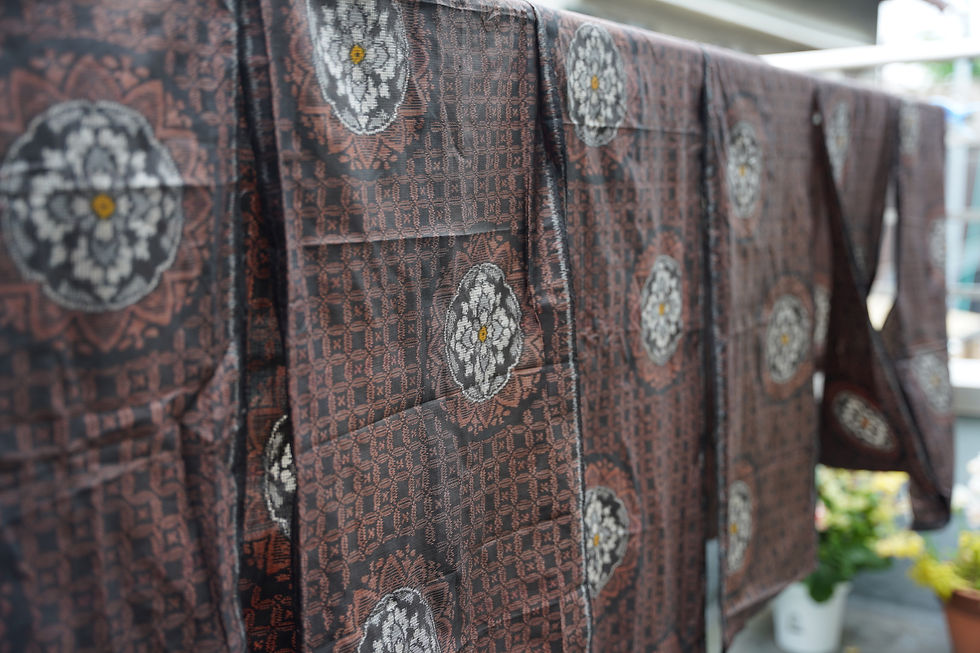
How to care
People in the old days used to untie their kimonos, turn them into cloth, and then wash them.
Kimono has been carefully cared for and has been carefully handed down for generations.
Even if you are reborn as "Happy Fuku", I would like you to keep your feelings and wear them for a long time.
We will introduce a simple maintenance method that you can do at home.
Depending on the material, color transfer or shrinkage may occur, so if you are a Ki, we recommend that you bring it to a cleaning shop or specialty store.

01 01
wash
Dissolve the neutral detergent in a tub of water.
Put the folded kimono there and gently press and wash it by hand.
A little emphasis is placed on the dirty parts that become ki.
No bleach is used.
It is not recommended to leave it for a long time as some materials may have discoloration or color transfer.
02 02
Dehydration
Put the folded kimono in the net and dehydrate it for about 3 minutes.
After this, it will be rinsed again, so it is enough to remove some water.


03 03
Rinse and dehydration
After dehydration, rinse again with a tub of water to thoroughly remove the detergent.
Put it in the net and dehydrate it for about 3 minutes as before.
A guideline is that it is still a little wet.
04 04
Shade drying
After dehydration, dry in the shade.
The drying time varies depending on the season, but wrinkles will remain when it is completely dried, so please dry it in the shade until it is half-dried.


05 05
Ironing
Iron in a semi-dry state.
Apply a cloth and set the temperature of the iron at a low temperature or a temperature dedicated to silk.
Here, smooth out the wrinkles.
06 06
Maintenance completed
If the wrinkles have grown cleanly and there are still some areas that are not dry, dry them in the shade.
When it is completely dry, cleaning is complete.

Care
Caution
The charm of kimono is that it can be passed down from parent to child by re-making it.
It is quite natural that you will want to continue to use "Happy Fuku" for a long time, just like the precious kimono inherited from your family.
"Happy Fuku" can be washed at home.
You can enjoy "Happy Fuku" for a long time with just a little effort and time.
We recommend hand washing .
The only detergents used are neutral detergent (for fashionable clothes), baking soda, or washing with water.
I am using kimono fabric, not new one.
Kimono fabrics are made of natural materials such as silk, cotton, linen and wool .
The condition of the fabric varies depending on the age when the kimono was made and how long it was used .
After washing properly , dehydrate by squeezing water lightly according to the condition of the dough .
We recommend that you consult with a specialist for care of squeezed fabrics, discolored fabrics, and special fabrics with decorations .
Also, even if it is easy to clean at home, the color may fade, the fabric may shrink, or it may lose its shape .
If you are interested in them, we recommend that you bring them to a cleaning shop or specialty store.
If you use a detergent containing bleach, the color may fade.
If you use detergent, use a neutral detergent or baking soda.
If you wash it with other clothes, it may cause color transfer, so we recommend that you do not wash it with white or light fabrics.
To prevent it from losing its shape , when dehydrating it in a washing machine, fold it carefully and put it in the net.
Also, depending on the condition of the fabric, you can avoid dehydration using a washing machine and lightly hold it down with a towel to remove water.
When drying after dehydration, it is recommended to avoid direct sunlight and dry in the shade as in fashionable clothes .
You can prevent wrinkles after drying by smoothing out the wrinkles and drying them in a semi-dry state.
It is possible to smooth out wrinkles by ironing in a semi-dry state.
When ironing, you can adjust the temperature according to the fabric such as silk, linen, cotton and wool, and use it as a patch .
Avoid ironing where there are squeezes and decorations .
In order for you to use "Happy Fuku" for a long time, we will introduce a simple method of care at home.
Since we use natural materials, the texture and texture of the fabric will change little by little.
I hope that you will enjoy the change for many years as a good kimono fabric using natural materials.

